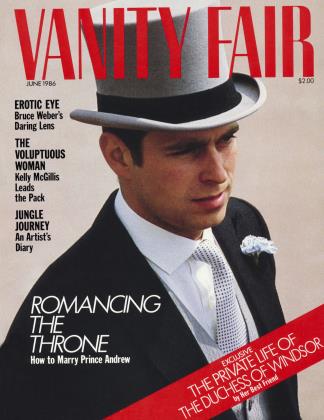Sign In to Your Account
Subscribers have complete access to the archive.
Sign In Not a Subscriber?Join NowHot Type
oodness! What a year I it's been. Stocks going through the roof, America proud again. And with 1928 nearly half over, the elegant characters of Brooke Astor's lovely little novel of New York society, The Last Blossom on the Plum Tree (Random House), celebrate at all the best places. They drink at Jack and Charlie's (the stuffy Knickerbocker Club is dry), lunch at the Ritz's Japanese Garden, tango on the Ziegfeld Roof, shoot at the Deepdale Country Club. In between, all fall madly in love.
What's endearing about this particular troupe is that most of the smartly dressed women are widows whose prospects are much younger men. Condemned by their social station to slog through dreary dinners together and bump into each other from Fifth Avenue to Paris to Portofino, the widows and their wooed grow more and more madcap, their passions more and more base. (Writes Mrs. Astor of a young lawyer's sexual frustration: "He was at starvation comer!") One wishes, at times, for a soup^on more madness; the lovers occasionally seem a trifle unsure when to be proper and when to be pie-eyed. No matter. The loose ends get tied up as prettily as pink bows, and love with a younger man, it turns out, isn't always a tragic affair.
Michael Shnayerson
Someone said of Edith Sitwell that her work was part of the history of publicity but not of literature. The opposite might be said of William Trevor: reading his ambitious, subtle, luminous short stories, it seems odd that he is not even better known. For, as The News from Ireland (Elisabeth Sifton Books/Viking) shows once again, ^ Trevor is perhaps the finest short-story writer in the English language—an Anglo-Irish successor to the late John Cheever. Trevor's stories sometimes appear slighter than they are; it is only afterward that one realizes his mastery of language and his profound, unsentimental humanity. The title piece of this collection, set in Ireland in 1847 and 1848, shows Trevor's gifts to best effect. In it, Fogarty, a poor Protestant butler, reveals to Miss Heddoe, a governess newly arrived from England, the tragedy and horror of the Ireland of the Famine. She listens seriously (Trevor's characters really listen as well as really talk) and records her impressions and her distress in a diary. In time, however, this "young woman of principle and sensibility" comes to terms with this "news.'' The story concludes: "She has wept into her pillow, she has been sick at heart. Stranger and visitor, she has written in her diary the news from Ireland. Stranger and visitor, she has learnt to live with things."
David Rieff
s a semiotician, Umberto Eco has a [justifiable obsession with details. In The Name of the Rose he built a whole monastery from thousands of microscopic bits of data. And in the title essay of Travels in Hyperreality (Harcourt Brace Jovanovich) he takes apart contemporary American kitsch. To demonstrate that "the American imagination demands the real thing and, to attain it, must fabricate the absolute fake," Eco immerses himself in theme parks and waxworks, Disneyland and the Forest Lawn cemeteries.
The garish jungle of "signs" proves almost too much for Eco: it sends him into manic, frequently hilarious flights of recapitulation, ricocheting from Brazilian occultism to designer jeans to Charles Manson. Eco delights in unforeseen connections: in New York City he finds neo-feudal castles (Citicorp Center and Trump Tower), "with their courts open to peasants and merchants and the well-protected high-level apartments reserved for the lords." While not all his journalistic pieces have worn equally well, at his best Eco is an ideal intellectual companion: sharp, enthusiastic, and alive to the grotesqueness of the ordinary.
Geoffrey O'Brien
 View Full Issue
View Full Issue
























Subscribers have complete access to the archive.
Sign In Not a Subscriber?Join Now